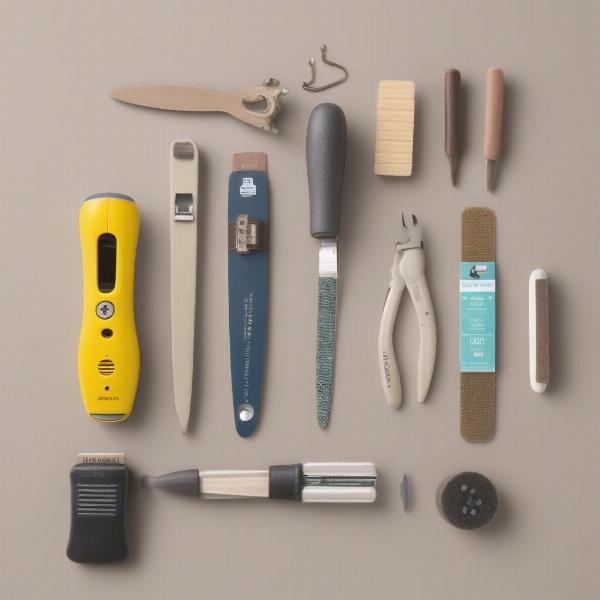Taking care of your dog’s nails is an essential part of their overall health and well-being. Using a nail file for dogs offers a gentle and controlled way to maintain their nail length, preventing a host of potential problems. This guide will cover everything you need to know about choosing the right nail file, using it correctly, and ensuring a comfortable experience for both you and your furry friend.
Choosing the Right Nail File for Your Dog
 Choosing the right dog nail file
Choosing the right dog nail file
Several types of nail files are available for dogs, each with its own pros and cons. Electric grinders offer speed and efficiency, but can be intimidating for some dogs due to the noise and vibration. Manual files provide more control and are a quieter option, making them ideal for anxious dogs. Emery boards, while effective for smoothing rough edges, may not be the best choice for shortening long nails. Consider your dog’s temperament, nail thickness, and your own comfort level when making your selection.
How to Use a Nail File on Your Dog
Introduce the nail file gradually to your dog, allowing them to sniff and investigate it. Reward calm behavior with treats and praise. Hold your dog’s paw firmly but gently, and file the nail at a 45-degree angle, following the natural curve of the nail. Avoid filing the quick, the pink part of the nail containing nerves and blood vessels. File in short strokes, frequently checking for signs of discomfort. If your dog becomes anxious or stressed, take a break and try again later.
Benefits of Using a Nail File for Dogs
Filing your dog’s nails regularly offers several advantages. It prevents overgrowth, which can lead to discomfort, difficulty walking, and even joint problems. Filing also helps to smooth out rough edges, reducing the risk of snagging and tearing. Furthermore, using a nail file can be less stressful for some dogs compared to traditional clippers, especially those with a fear of the clipping sound. For large dogs, a nail file can be particularly helpful in managing thick nails that are difficult to clip with traditional dog nail clippers for large dogs.
Common Mistakes to Avoid
One of the most common mistakes is filing the quick, which can cause pain and bleeding. Another common error is filing the nail too short, which can also be painful. Be sure to file in short strokes and check the nail length frequently. Applying too much pressure can also cause discomfort. Start with light pressure and gradually increase as needed. Remember, patience is key, especially when working with anxious dogs or using small dog nail clippers.
What if I Cut the Quick?
Accidents happen, and even experienced pet owners can occasionally cut the quick. If this occurs, apply styptic powder or cornstarch to the bleeding nail to stop the bleeding. Keep your dog calm and reassure them. If the bleeding persists or the nail appears infected, consult your veterinarian.
Conclusion
Using a nail file for dogs is a safe and effective method for maintaining their nail health. By choosing the right file, using the correct technique, and avoiding common mistakes, you can ensure a comfortable and stress-free experience for both you and your furry companion. Regular nail care is essential for your dog’s overall health and well-being, contributing to their comfort and mobility. Don’t hesitate to explore various dog nail clippers if filing doesn’t suit your dog.
FAQ
- How often should I file my dog’s nails? It depends on the breed and how quickly their nails grow. Generally, every 2-4 weeks is recommended.
- Can I use a human nail file on my dog? While possible, it’s best to use a nail file specifically designed for dogs, as they are often more durable and effective. Knowing where can i get dog nails clipped can be helpful if you’re uncomfortable doing it yourself.
- What if my dog won’t let me file their nails? Try desensitizing them to the process gradually, using positive reinforcement. If they remain resistant, consider seeking professional grooming services.
- Is it better to file or clip a dog’s nails? Both methods are effective. Choose the method that is most comfortable for you and your dog. Using a nail file board for dogs can offer better control.
- What are the signs of an infected nail? Swelling, redness, discharge, and lameness can be signs of an infected nail. Consult your veterinarian if you notice these symptoms.
ILM Dog is a leading online resource dedicated to providing dog owners with reliable, practical advice on all aspects of canine care. From breed selection and health to training and nutrition, ILM Dog offers expert guidance and helpful tips to help you provide the best possible care for your furry friend. Whether you are a new dog owner or a seasoned pro, ILM Dog has the information you need to keep your canine companion happy and healthy. Contact us for any inquiries: Email: [email protected], Phone: +44 20-3965-8624.